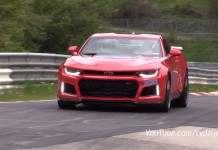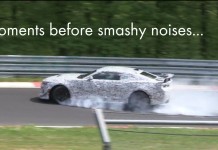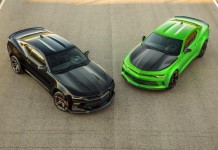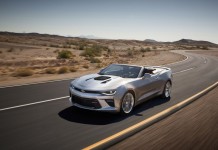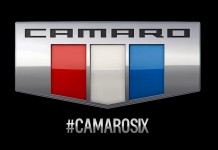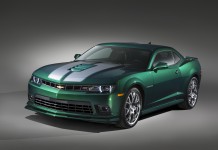The fifth generation Chevrolet Camaro is General Motor’s most popular vehicle. The modern-day muscle machine has nearly 2 million ‘fans’ on its official Facebook page, which is more than any other manufacture’s individual vehicles. Since its debut in 2010, the Camaro in all its variations is also one of the best selling sports cars in the United States and does battle with its American, German and Japanese rivals each and every day. In order for it to stay competitive, Chevy has been working hard to create as many different versions of their Canadian built pony car as they can come up with. There are a variety of engine, transmission and body style options to mix and match, which means there is a Camaro out there for almost anyone. To see if there can be a balance between style, power and efficiency, the 2012 Convertible fitted with the V6 and six speed automatic will have a lot to accomplish.

The 2012 model year is a big one for the Camaro. Not only will the most powerful production model make its way on to showroom floors, the ZL1, but the base six cylinder has received some attention as well. When it was first introduced, the direct injected DOHC 3.6 liter V6 retained a cast-iron intake and exhaust manifold and produced 306 horsepower. A slight jump in power was made for 2011 but there was still room for improvement. Even with 312 horsepower, the 2011 V6 that we tested earlier in the year was not chalk-full of low-end torque and had to be revved high to feel any real thrust. Chevrolet engineers went to work and added some serious engine tech to the still 3.6 liter. Now pumping out 324 horsepower and 278 lb-ft of torque, the 2012 makes more power by way of an all-new cylinder head/exhaust manifold system. Made out of aluminum, the new design save 13 lbs compared to the 2011 by combining the heads with the exhaust manifold, thus eliminating the gaskets, heat shields and 18 extra bolts. This bump in power and loss in weight puts the base V6 Camaro into never before seen territory: right up against the heavy hitters from Japan and German such as Infiniti’s G37 and BMW’s 335i.


A 12 horsepower and 5 lb-ft of torque boost might not seem like much on paper, but the 2012 is noticeably faster off paper when compared to the 2011. Throttle response is improved and the engine’s pull seems to come on much sooner. One of the biggest grips we had with the 2011 V6 was its peaky nature which, for the most part, has been extinguished. The 3.6 simply feels stronger than before: so much so that if it wasn’t for its sound it could be mistaken for a small V8. It is still eager to rev and does so all the way to redline accompanied by a strangely un-American song. Mechanical sounding at most revolutions, the six cylinder sounds like a Nissan VQ, but less raspy. It’s no SS rumble and grumble, but anyone with a soul won’t complain about the 3.6’s blast through its six gears. Despite not having a clutch, the Hydra-Matic is a wonderful piece of work. This is one of the best automatic transmissions on the sports car market: never clunky or slow and always smooth. When placed in manual mode, the six speed holds on to whatever gear the driver has selected. If holding 6,000 rpms in first gear for a tight and long hairpin is needed, the Hydra-Matic will comply. In all honesty, this auto might even make not living with a third pedal bearable: even for a car guy.

Taking a corner fast in the V6 Convertible is oddly more confidence inspiring than it its big V8 brother. The same light, agile and communicative feel that was felt in the 2011 V6 is present in the 2012. If anything, the lighter weight of the new 3.6 made turn in quicker, letting the new car enter sweepers at a higher rate. The long wheelbase of the Zeta platform means all Camaros prefer fast onramps to sharp 90 degree corners, but most buyers of a grand touring convertible won’t be autocrossing their rides each and every Sunday. When it comes to hard drivng, fast lanes and long, winding mountain passes are the Convertible’s best friend. However, understeer can and will present itself during sharp, lower speed turns. Blame can be placed on the car’s lot in life as these are more cruisers than true sports cars. After all, the convertible is massive: weighing nearly two tons. Twenty years ago, that was how much a full size SUV weighed.

Inside the 2012, a driver won’t notice any real change. Our tester, fitted as a 2LT, carries a base MSRP of $34,1oo. Included in that price are standard features such as Boston Acoustics supplied stereo, heads up display, auxiliary gauges and a leather wrapped steering wheel. Added to our tester were the $500 interior accent package (aesthetics), $1,375 RS exterior package that adds 20 inch wheels and $470 worth of orange stripes. With destination charge and the $1,185 automatic, total MSRP for our Summit White convertible stood at $38,530.





Ergonomically, the Camaro is good and bad. Placement of certain items such as the shift knob, climate controls, radio dials and steering wheel mounted shift tabs are dead on. Even so, it takes a while to get comfortably situated in any fifth gen. Either a driver will be sunk in too low or the seat back won’t seem mesh well with the steering wheel’s placement. Outward visibility is somewhat of an issue as the car is so big, a driver might find it difficult to figure out where the front end actually is. Looking out of the front window is nothing compared to this car’s biggest grip: its rearward visibility. With the top up, the convertible’s blind spots are so big that a school bus would get lost in them. Backing out of a parking spot can be somewhat dangerous as too much care is needed to figure out where the car is pointed. Back up warning chimes kick when things get too close, but that really isn’t enough. All Camaro’s, especially the convertibles, should be fitted with a proper back up camera. Period.

The fifth generation Chevrolet Camaro is and always has been a proper grand touring car. Sure, when it first came on to the scene the V6 model was a little gutless but the engineers at GM have successfully evolved it and in a relatively short time. Now in its third model year, the base Camaro is finally seat-of-the pants quick and might even hurt some SS sales. It might lack the luxury of some of its Japanese and German rivals, but it undercuts their MSRPs by thousands and there is no doubt that any fifth gen isn’t well made. The fit and finish on the Camaro’s is surprising: especially given the namesake’s sketchy history. With the assistance of the excellent six speed automatic, the new and improved 3.6 liter is more fuel-efficient than ever too. EPA ratings have climbed ever so slightly to 18 mpg in the city and 29 on the highway. With our heavy, journalist feet, we managed to average 19 mpg in the city. What Chevrolet has done for the 2012 model year is give the base Camaro Convertible a fighting chance. It’s still neck-snapping pretty, frisky in the twisties and classically comfortable but, with a slight bump in power, the smiles can now stay strong for miles on end.
Photos: © Copyright 2011 Ossamah Shabbir


